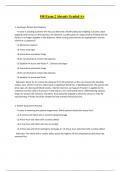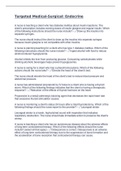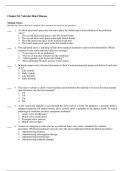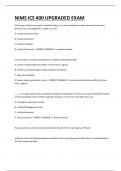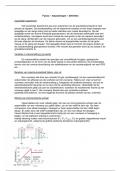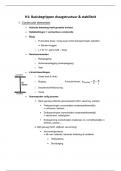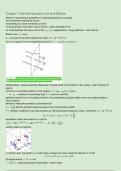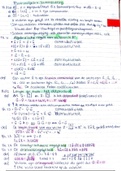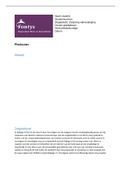1. Assisting a Patient Post-Delivery
- A nurse is assisting a patient who has just delivered a healthy baby boy weighing 7 pounds. Upon
applying cord traction on the placenta, she observes a sudden gush of a large volume of blood and the
fundus is no longer palpable in the abdomen. What nursing interventions are appropriate if uterine
inversion is suspected?
- 1) Administer oxytocic
- 2) Assess vital signs
- 3) Discontinue uterotonic drugs
- 4) Do not attempt to remove the placenta
- 5) Establish IV access and fluids ✔️2) Assess vital signs
- 3) Discontinue uterotonic drugs
- 4) Do not attempt to remove the placenta
- 5) Establish IV access and fluids
Rationale: Never try to remove the placenta if it's still attached, as this can increase the bleeding
surface area. Uterine inversion often leads to significant blood loss. If bleeding persists, the woman will
show signs of a decreased blood volume. Uterine inversion can happen if traction is applied to the
umbilical cord too early or if pressure is exerted on a non-contracted uterus. Administering oxytocic
drugs can worsen the inversion; therefore, they should be stopped to allow the uterus to relax for
repositioning. IV fluids should be initiated to help maintain blood pressure.
2. Patient Assessment Priority
- A nurse is reviewing her patient assignments. Which patient should she assess first?
- 1) A 12-hour-old infant who is small for gestational age
- 2) A four-hour-old infant with a cardiac defect
- 3) A nine-hour-old infant who has not voided
- 4) A three-day-old infant waiting for discharge ✔️2) A four-hour-old infant with a cardiac defect
Rationale: The infant with a cardiac defect poses the highest risk for complications and should be
assessed first.
,3. Risk Factors for Preeclampsia
- At 32 weeks' gestation, a 15-year-old primigravid client who is 5'2" has gained 20 lbs, with a 1 lb
weight gain in the last two weeks. A urinalysis shows negative glucose and a trace of protein. The nurse
should highlight which factor as increasing her risk for preeclampsia?
- 1) Total weight gain
- 2) Short stature
- 3) Adolescent age group
- 4) Proteinuria ✔️3) Adolescent age group
Rationale: Clients at elevated risk for preeclampsia include primigravid women younger than 20 or
older than 40, those with five or more pregnancies, women of color, multifetal pregnancies, and those
with diabetes or heart issues. A weight gain of 20 lbs at 32 weeks, with a recent gain of 1 lb, is within
normal limits. Trace protein in urine is normal, while +1 or more could indicate pregnancy-induced
hypertension.
4. Action for Meconium-Stained Amniotic Fluid
- A patient presents with meconium-stained amniotic fluid. Fetal scalp sampling indicates a blood pH
of 7.12, and fetal bradycardia is noted. Based on these findings, what should the nurse do next?
- 1) Administer amnioinfusion
- 2) Prepare for cesarean section
- 3) Reposition the patient
- 4) Start IV as prescribed ✔️2) Prepare for cesarean section
Rationale: Infants with meconium-stained amniotic fluid may face respiratory issues and bradycardia
at birth. This assessment suggests fetal metabolic acidosis, posing a significant risk to the newborn’s
health, warranting a cesarean section.
5. Definition of Premature Rupture of Membranes
- What is premature rupture of membranes? ✔️Premature rupture of membranes refers to the
spontaneous rupture of the amniotic membrane before labor begins. If this rupture occurs before term,
it increases the risk of infection.
6. Hormones Secreted by the Corpus Luteum
- What hormones are secreted by the corpus luteum? ✔️The corpus luteum secretes estrogen and
progesterone during the last 14 days of the menstrual cycle.
, 7. Normal Intrauterine Fetal Attitude
- What is the normal intrauterine fetal attitude? ✔️The normal intrauterine attitude refers to the
relationship among fetal body parts. Typically, this is flexion, where the fetal back curves, the head is
tilted forward on the chest, and the arms and legs are folded against the body.
8. Definition of Secondary Amenorrhea
- Absence of menstruation for six months or more in a patient with prior normal menstrual cycles is
known as? ✔️Secondary amenorrhea.
9. Definition of the Postpartum Period
- What is the postpartum period? ✔️The postpartum period begins immediately after delivery and
usually lasts until approximately six weeks postpartum.
10. Rooting Reflex in Newborns
- What is the rooting reflex? ✔️The rooting reflex occurs when the newborn's lip, cheek, or mouth
corner is touched with a nipple, prompting the baby to turn its head toward the nipple and open its
mouth. This reflex usually fades after 3 to 4 months.
11. Contraction Stress Test Interventions
- What are the interventions for the contraction stress test? ✔️An external fetal monitor is applied,
and a 20-minute baseline strip is recorded before stimulating the uterus with (Pitocin) or nipple
stimulation until three contractions occur that last 40 seconds or more within a 10-minute period.
12. Assessment for Premature Rupture of Membranes
- What are the assessments for premature rupture of membranes? ✔️Fluid pooling in the vaginal
vault; a positive Nitrazine test; assessment of fluid amount, color, consistency, and odor; and monitoring
for elevated temperature, which may indicate infection.
13. Assessment for Meconium Aspiration Syndrome
- What are the assessments for meconium aspiration syndrome? ✔️Signs of respiratory distress at
birth such as tachypnea, cyanosis, retractions, nasal flaring, grunting, crackles, and rhonchi, along with
yellow-green staining on nails, skin, and umbilical cord.

